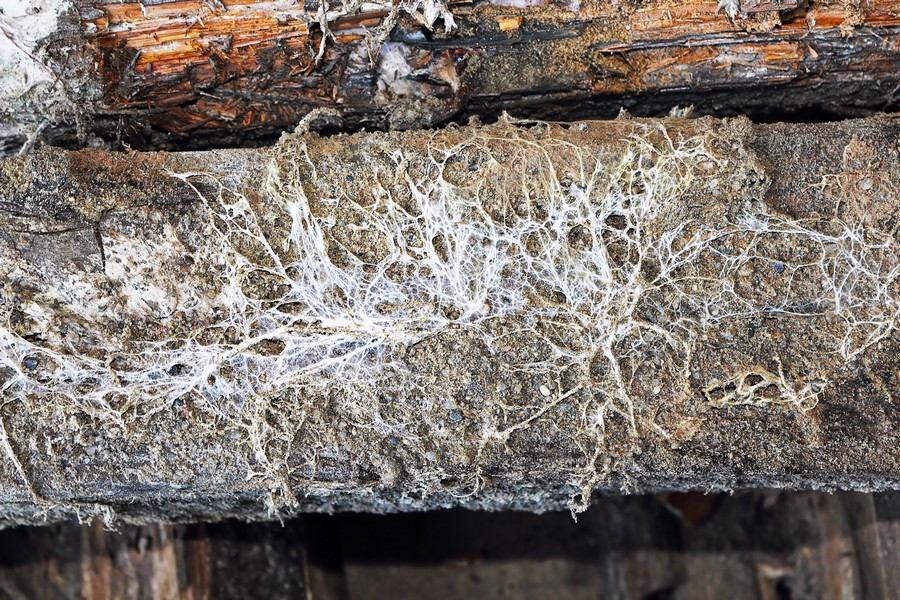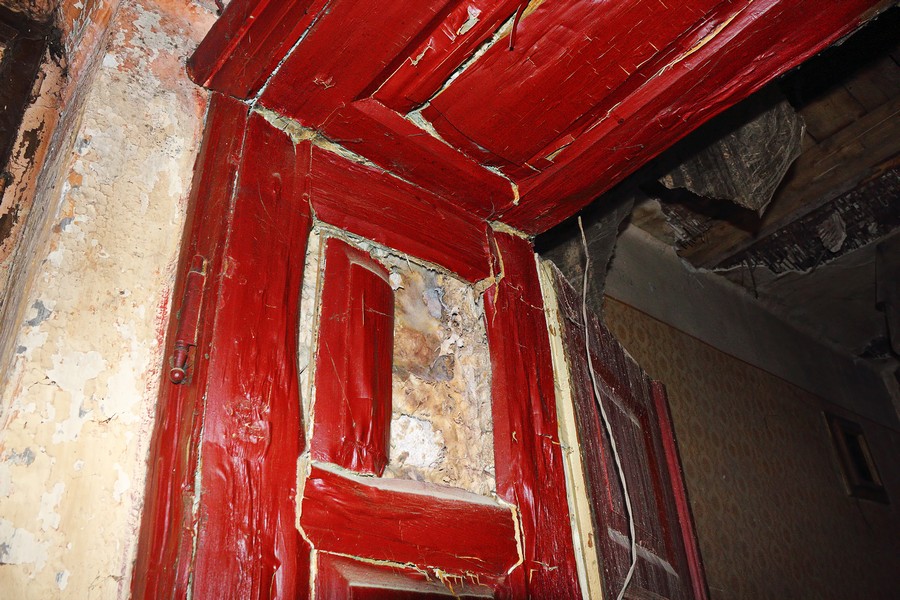Contact Brighton Damp Treatments Now to Speak With an Expert.

Dry rot is a form of wood degradation caused by fungi that disintegrates the strength and rigidity-giving components. Historically, it was utilised to refer to any decay of cured wood in ships and structures, making the wood darkly coloured, weakened, and fractured.
Dry rot is a kind of brown rot caused by certain fungi that weaken wood in buildings and other wooden structures, even without an apparent source of moisture. The term “dry” rot is misleading since all wood-rotting fungus needs a certain level of moisture to start decaying. Dry rot fungi degrade timber using the same chemical process as other brown rots – the rotting wood takes on a black or dark brown crumbly look, with splintering or cracking into cubes, and becomes fragile enough to be easily crushed into powder.
A dry rot infestation in a structure is dangerous and difficult to remove; thus, prompt action should be taken. Failure to do so can cause extensive damage leading to structural instability and even collapse of the building.

Dry rot and wet rot have diverse spores, thus they possess distinct appearances. The key distinction is that wet rot necessitates much more moisture for propagation since it can disseminate through capillaries. Moreover, it can be spread across larger areas with greater ease.
Serpula lacrymans is the most common fungus causing dry rot in the UK. If not addressed promptly, it can spread through your home – encompassing brick, stone and plaster – impacting both your house’s structural integrity as well as that of timbers.
If there is an abundance of moisture in your wood, it can lead to dry rot. At a humidity level of over 20%, the spores form quickly and attract fungus that feeds on the wetness for sustenance.
A specialist survey is necessary to determine if your decaying timber is due to dry rot or another type of fungus. Treatment options will depend on the cause.
Be aware of the signs and symptoms of dry rot so that it can be detected promptly. Early discovery will save time and money in addressing it. A full assessment is necessary if any of these indications are noticed.
When timber is afflicted with dry rot, it tends to become brittle and dry. In some cases, the wood may even disintegrate. The colour of your wood will also suffer due to this condition. Dry rot has a particular tendency to cause cuboidal cracking; when the wood splits into cubes around 50 mm in diameter. It’s common for hyphae – white fungal growth resembling cobwebs – to be found on damaged wood as an indication of dry rot.

The musty smell of dry rot is particularly strong. Your timbers will give off a damp, fungal, murky odour if they have been affected by the fungus. Dry rot can occur without being visible; however, presence of an aroma doesn’t necessarily suggest its existence. The scent will indicate that your timber is moist – and humidity could result in dry rot later on.
The ultimate and most visible sign of dry rot is the emergence of fruiting bodies that resemble mushrooms on wood. When the fungus has exhausted its food supply, it emits spores as a means of propagation.
If a rusty coloured dust is present alongside dry rot spores, it can be an indication of the infection. At the last stage of the cycle, fruiting bodies will emit spore dust.
Contact Brighton Damp Treatments Now to Speak With an Expert.
Wood rot and dampness can do significant damage to wood and masonry, as well as cause great disruption and cost to remove. The only way to deal with this issue is by halting the source of dampness, and removing the fungus.
We take dry rot seriously. If left untreated, it can quickly spread throughout your home causing severe structural damage that could cost thousands of pounds to repair. Each fungus spore has the potential for starting a new epidemic on your property. To ensure we address the problem effectively, we first identify and eliminate the source of dampness. Damaged timbers are then cut out beyond where any mycelium is visible before replacing them with pre-treated lumber and re-plastering according to our specifications. The walls and surviving timbers also receive a thorough treatment with high-performance timber preservatives.
Call Our Brighton Damp Experts team now for a free quote, consultation and advice.
Dry rot poses a serious threat to the structural integrity of your home, making it far more than just an inconvenience. Its odour, appearance and feel may be cause for concern but are minor in comparison to its potential for compromising your property’s saleability.
If your home environment is conducive to dry rot, it can be detrimental to one’s health. Elderly people, children and those with respiratory conditions such as asthma are particularly at risk.
If you think your home or business might have dry rot, we highly recommend booking a professional timber survey. Reach out to our team today on 01273 920588 or fill in the contact form and arrange a comprehensive property inspection with our specialists.
Our timber rot experts will detect dry rot in wet wood and ascertain the moisture content of afflicted timbers. They’ll explain the causes and suggest treatment plans to eradicate this timber-destroying fungus.

If you have identified dry rot fungus, a specialist will be able to trace its spread across masonry and plaster.
Brighton Damp Treatments have completed numerous surveys and restoration projects for both domestic and business premises. We are renowned as one of Brighton’s foremost experts in dry rot, damp proofing, water damage and woodworm elimination. Many customers have profited from our professional treatment of dry rot and dampness resulting in a long-term fix to their problem. Our plastering follows the Brighton Damp Treatments’ Dry Rot & Damp Proofing Re-plaster Method with only top quality preservatives used for timber protection.
Brighton Damp Treatments are experts in damp proofing, boasting experience with a variety of services, including:
The project included installing a new damp proof course, expertly plastering for damp proofing, and refixing joinery timbers.
The project involved installing a new damp proof course, expertly plastering to prevent dampness and refixing joinery timbers.
Penetrating damp can be remedied by structurally waterproofing walls below ground level, known as basement tanking.
The installation of a Cavity Drain Membrane System (CDM) can be used to waterproof basements, cellars and vaults.
We offer restoration services for water damage caused by burst pipes. We serve both private customers and insurance companies.
Positive and passive ventilation systems are employed to manage condensation and mould.
The timber must be treated to prevent any rot or decay. The treatment should involve pressure impregnation of a preservative into the wood, and it is recommended that this process is done at least twice with different solutions. This will ensure that the timber has adequate protection from rot or decay for up to 25 years.
Timber needs treating in order to stave off rot and decay. Pressure-impregnating a preservative into the wood should be done two times using distinct solutions for optimal protection against deterioration for up to twenty-five years.

Eradicate and repair dry rot;
Take action to eliminate and fix any problems with dry rot.
The elimination of woodworms and wet rot is essential. This must be done in order to preserve the integrity of the wooden structure in question; otherwise, it can lead to weakening of the material and eventual collapse.
Repairing cracked bricks and replacing cavity wall ties can be done to restore the structure of a building.
Blocked drains and structural resin lining are an issue we address. We have the tools, experience and expertise to unblock your drains and apply a structural resin lining if necessary.


Max and his team have been at our property all week and I really can’t thank them enough for the fantastic job they’ve done on plastering both our walls and ceilings. They have literally transformed the appearance of our house! Not only has Ma…
From start to finish Max has been incredable. His knowledge lin damp proofing is second to none and his team where very clean and polite. The plastered finish was like glass so happy we choose Max Plastering for job.
Lovely bunch of lads left a very neat and clean job. Problem was solved.
Perfect Finnish and all left clean and tidy and no mess. Used Max previously and would not hesitate to ask him carry out more work.
Max, Harvey and Stuart arrived promptly as arranged. Done a great job on our outside rear wall. Work completed to a high standard, removal of all old material and cleaned up after themselves. I am so pleased with the standard of their work they ar…
They turned up on time and carried out the works in a very professional manor leaving the front of the house clean and tidy. Very impressed would definitely recommend.
I have to say that on every level Max (with Stuart and Harvey) did an extremely professional job! They explained what they were going to do, they were polite and courteous and respected that they were coming into our home. The plastering is of the…
I called max and he managed to come around the same day to do a survey. The next day I received an extremely detailed survey compared to any other damp proofer which made me feel very at ease that he was going to do the right job. Max and team tur…
Contact Brighton Damp Treatments Now to Speak With an Expert.